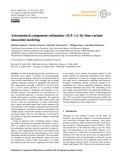Mostrar el registro sencillo del ítem
Astronomical component estimation (ACE v.1) by time-variant sinusoidal modeling
| dc.creator | Sinnesael, Matthias | es_ES |
| dc.creator | Zivanovic, Miroslav | es_ES |
| dc.creator | Vleeschouwer, David De | es_ES |
| dc.creator | Claeys, Philippe | es_ES |
| dc.creator | Schoukens, Johan | es_ES |
| dc.date.accessioned | 2018-09-04T06:43:55Z | |
| dc.date.available | 2018-09-04T06:43:55Z | |
| dc.date.issued | 2016 | |
| dc.identifier.issn | 1991-959X (Print) | |
| dc.identifier.issn | 1991-9603 (Electronic) | |
| dc.identifier.uri | https://hdl.handle.net/2454/30454 | |
| dc.description.abstract | Accurately deciphering periodic variations in paleoclimate proxy signals is essential for cyclostratigraphy. Classical spectral analysis often relies on methods based on (fast) Fourier transformation. This technique has no unique solution separating variations in amplitude and frequency. This characteristic can make it difficult to correctly interpret a proxy's power spectrum or to accurately evaluate simultaneous changes in amplitude and frequency in evolutionary analyses. This drawback is circumvented by using a polynomial approach to estimate instantaneous amplitude and frequency in orbital components. This approach was proven useful to characterize audio signals (music and speech), which are non-stationary in nature. Paleoclimate proxy signals and audio signals share similar dynamics; the only difference is the frequency relationship between the different components. A harmonic-frequency relationship exists in audio signals, whereas this relation is non-harmonic in paleoclimate signals. However, this difference is irrelevant for the problem of separating simultaneous changes in amplitude and frequency. Using an approach with overlapping analysis frames, the model (Astronomical Component Estimation, version 1: ACE v.1) captures time variations of an orbital component by modulating a stationary sinusoid centered at its mean frequency, with a single polynomial. Hence, the parameters that determine the model are the mean frequency of the orbital component and the polynomial coefficients. The first parameter depends on geologic interpretations, whereas the latter are estimated by means of linear least-squares. As output, the model provides the orbital component waveform, either in the depth or time domain. Uncertainty analyses of the model estimates are performed using Monte Carlo simulations. Furthermore, it allows for a unique decomposition of the signal into its instantaneous amplitude and frequency. Frequency modulation patterns reconstruct changes in accumulation rate, whereas amplitude modulation identifies eccentricity-modulated precession. The functioning of the time-variant sinusoidal model is illustrated and validated using a synthetic insolation signal. The new modeling approach is tested on two case studies: (1) a Pliocene–Pleistocene benthic δ18O record from Ocean Drilling Program (ODP) Site 846 and (2) a Danian magnetic susceptibility record from the Contessa Highway section, Gubbio, Italy. | en |
| dc.description.sponsorship | Matthias Sinnesael thanks the Research Foundation – Flanders (FWO) for the awarded PhD fellowship (FWOTM782). David De Vleeschouwer was funded through European Research Council (ERC) Consolidator Grant “Earthsequencing” (grant agreement no. 617462). This work was supported in part by the Fund for Scientific Research (FWO-Vlaanderen grant G009113N and support to Johan Schoukens), by the Flemish Government (Methusalem METH1 to Johan Schoukens), and by the Belgian Government through the Inter University Pole of Attraction (IUAP VII) Program (P7/15 PLANET TOPERS and P7/19 DYSCO). | en |
| dc.format.extent | 15 p. | |
| dc.format.mimetype | application/pdf | en |
| dc.format.mimetype | application/zip | en |
| dc.language.iso | eng | en |
| dc.publisher | Copernicus Publications | en |
| dc.relation.ispartof | Geoscientific Model Development, 9, 3517–3531, 2016 | en |
| dc.rights | © Author(s) 2016. This work is distributed under the Creative Commons Attribution 3.0 License. | en |
| dc.rights.uri | https://creativecommons.org/licenses/by/3.0/ | |
| dc.subject | Astronomical component estimation (ACE v.1) | en |
| dc.subject | Time-variant sinusoidal modeling | en |
| dc.title | Astronomical component estimation (ACE v.1) by time-variant sinusoidal modeling | en |
| dc.type | info:eu-repo/semantics/article | en |
| dc.type | Artículo / Artikulua | es |
| dc.contributor.department | Ingeniería Eléctrica y Electrónica | es_ES |
| dc.contributor.department | Ingeniaritza Elektrikoa eta Elektronikoa | eu |
| dc.rights.accessRights | info:eu-repo/semantics/openAccess | en |
| dc.rights.accessRights | Acceso abierto / Sarbide irekia | es |
| dc.identifier.doi | 10.5194/gmd-9-3517-2016 | |
| dc.relation.publisherversion | https://doi.org/10.5194/gmd-9-3517-2016 | |
| dc.type.version | info:eu-repo/semantics/publishedVersion | en |
| dc.type.version | Versión publicada / Argitaratu den bertsioa | es |



